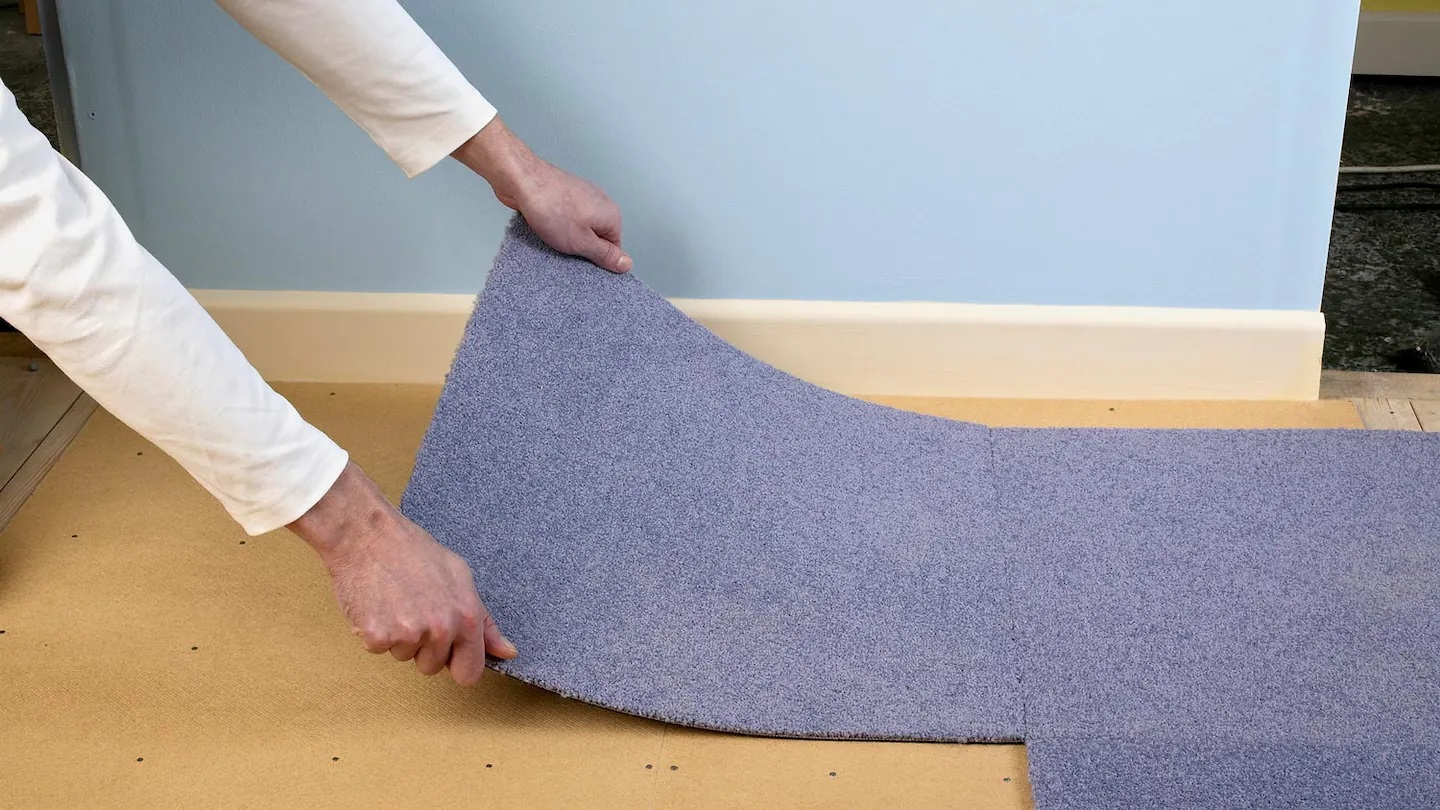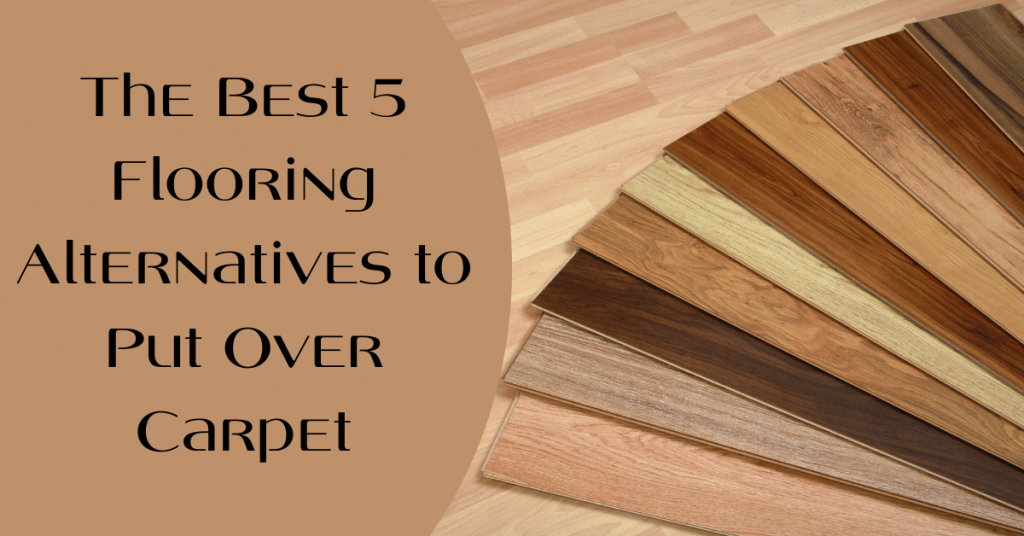Have you ever looked at your carpet and thought, “I wish I could have this cool wood floor instead?” It’s a common desire. But sometimes, ripping out existing carpet feels like a daunting task. The good news is that there are many types of flooring you can lay on top of your existing carpet, offering a fresh style without the hassle of a full removal. And if you’re looking to spruce up your home on a budget, this is a great option, sometimes even saving you the cost of removing the carpet altogether.

Image: www.archute.com
In this guide, we’ll explore the various flooring materials suitable for laying over carpet, diving into their advantages and drawbacks, and ultimately helping you make an informed decision for your home. We’ll also discuss tips for prepping your carpet for a new floor, as well as some common considerations you might have about the process.
Understanding the Basics of Flooring Over Carpet
Flooring over carpet is a popular DIY project. It’s often considered a cost-effective and time-saving alternative to full carpet removal, especially if you’re dealing with a thick carpet pad that provides a level surface. Though, it’s important to understand that the type of carpet you have will influence your options, as well as the type of new flooring you choose. Generally, you should be able to install flooring over carpet if it’s in good condition, with no rips or tears, and if the carpet pad is flat and not lumpy.
Before deciding to lay new flooring over your existing carpet, you should consider the following factors:
- Carpet thickness: The thickness of your existing carpet can significantly impact the type of flooring you can choose. If you have thick carpet, you may need to look for flooring that can accommodate the height difference.
- Carpet condition: The condition of your existing carpet will also play a role. If your carpet is damaged or uneven, it’s better to remove it and start fresh.
- New flooring choice: Different flooring types have different installation requirements and thickness, so choosing the right flooring for your situation is crucial.
The Right Flooring for Your Needs
There are several flooring options that can be laid over carpet, each with advantages and drawbacks. Here are some of the most popular choices:
1. Luxury Vinyl Plank (LVP)
LVP is a great choice for DIY projects, as it’s relatively easy to install and provides a beautiful, durable finish. It comes in various styles to mimic wood, tile, or stone, and is known for its water-resistance, making it ideal for kitchens, bathrooms, and even basements. When laying LVP over carpet, make sure your carpet is flat, and consider using a leveling compound for any minor imperfections.

Image: www.carpetandrugworld.com
2. Vinyl Sheet Flooring
Vinyl sheet flooring offers continuous seamless floors, providing a clean and modern look. It’s also budget-friendly and easy to clean. However, it can be less durable than other options, especially in high-traffic areas. Choosing a cushioned vinyl sheet can help soften the feel of your floors when installed over carpet.
3. Laminate Flooring
Laminate flooring is a cost-effective alternative to hardwood floors. It’s typically manufactured with a core layer of compressed wood fibers, topped with a decorative wear layer that mimics wood, stone, or tile. While laminate flooring is relatively easy to install, it’s not as water-resistant as some other options, so it’s best to avoid using it in bathrooms or kitchens.
4. Tile
Ceramic tiles or porcelain tiles are durable, water-resistant, and easy to clean, making them a popular choice for kitchens and bathrooms. However, installing tiles over existing carpet can be challenging due to the need for a level, solid substrate. You’ll likely need to consider using a cement board or similar product to create a suitable foundation for the tiles.
Tips for Success: Laying Your Flooring Over Carpet
Whether you’re working with LVP, tile, or laminate, here are some tips for achieving a successful flooring project over your existing carpet:
1. Prep Your Carpet
Before you jump into installation, your existing carpet needs attention.
- Check the condition: Your carpet should be in good condition, free of rips, tears, and significant stains. If damaged, removing the carpet entirely might be a better choice for a quality installation.
- Inspect your carpet pad: The pad should be flat and not lumpy. Any bumps or dips can show through your new flooring. Consider replacing the existing pad with a thin underlayment if it doesn’t meet these requirements.
- Clean thoroughly: Vacuum your carpet and consider steam cleaning to remove all dirt, dust, and debris. This will ensure a clean and smooth surface for your new flooring.
2. Consider Subfloor Leveling
If your carpet pad is uneven, you might want to consider using a leveling compound to create a smooth surface. This is particularly important for flooring materials like tile that require a perfectly flat substrate.
3. Use the Right Underlayment
Even with a flat carpet pad, you should use a suitable underlayment designed for your chosen flooring type. Underlayment provides insulation, cushioning, and sound absorption, offering additional support and protection.
4. Pay Attention to Transitions
Wherever your new flooring meets other surfaces, like different flooring materials or staircases, you’ll need to make sure transitions are smooth and seamless. Use transition strips, moldings, or trim pieces to create a polished finish.
5. Seek Professional Help When Needed
While installing new flooring over carpet can be a DIY project, it’s essential to know your limits. If you’re unsure about any part of the process, it’s always a good idea to consult with a professional flooring contractor. They can guide you on the best ways to install your flooring and ensure a quality job.
Frequently Asked Questions about Flooring Over Carpet
Here are some common questions about laying flooring over carpet:
Can you lay hardwood flooring over carpet?
Generally, it’s not recommended to lay traditional hardwood flooring directly over carpet. Hardwood requires a smooth, solid subfloor, and carpet isn’t the ideal surface. It’s best to remove the carpet and lay plywood over the subfloor to create a suitable base for hardwood.
Will laying flooring over carpet add to the height of the floor?
Yes, adding new flooring over existing carpet will increase the overall height. The amount of height difference will depend on the thickness of the carpet, the type of flooring you choose, and any underlayment you use. This is something to keep in mind, especially if you have doorways or transitions to other rooms.
How long will flooring laid over carpet last?
The longevity of flooring laid over carpet depends on the quality of the flooring, the condition of the carpet, and how well it’s installed. Proper preparation and careful installation are crucial for a long-lasting result. With proper care and maintenance, flooring laid over carpet can last for several years.
What Kind Of Flooring Can You Put Over Carpet
Conclusion: Creating Beautiful Floors with a Little Extra Layer
Laying new flooring over carpet can be a cost-effective and time-saving way to upgrade the look of your home. However, it’s important to do your research and choose the right flooring materials for your project. Keep in mind the considerations mentioned above, and don’t hesitate to seek professional help if needed. With careful planning and execution, you can create beautiful and long-lasting floors over your existing carpet.
Do you enjoy DIY projects like laying new flooring? Would you be interested in learning more about the different types of flooring and their installation methods? Tell us your thoughts in the comments below.





